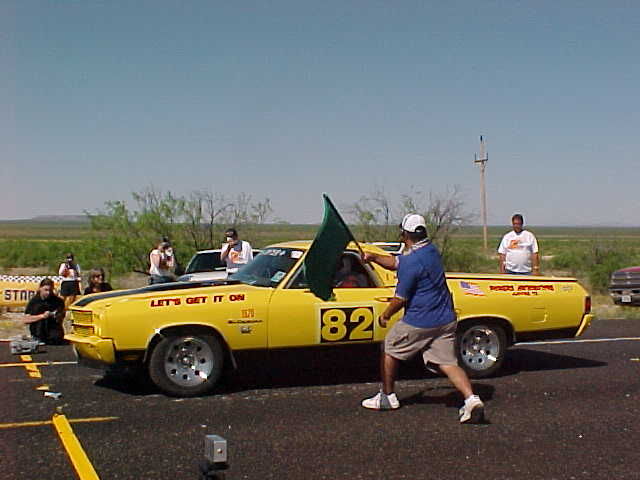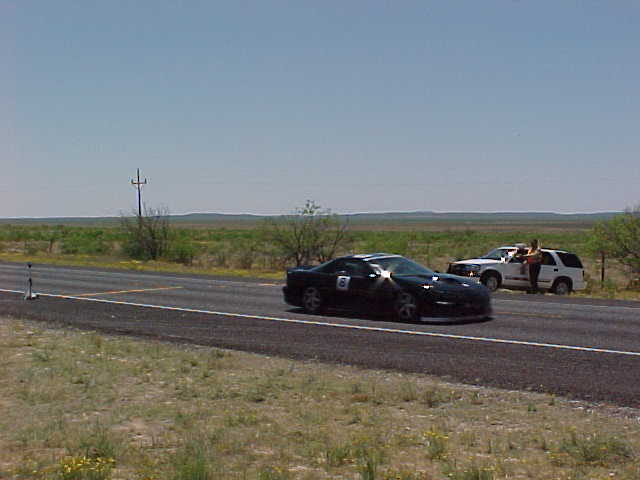Big Bend Open Road Race 2003
Article by Stephanie Sparkman,
courtesy of the Midland Reporter-Telegram.
They come from all over the country – New York, Michigan, Indiana, California, Nebraska, to name a few states – to a dusty Texas town that would have blown away a long time ago, except for the tenacity of the folks who call Her home.
Once a year, these visitors, who would otherwise have no reason to converge upon the small town of Ft. Stockton, a dry West Texas dot on Interstate 10, swoop in to race 59 miles of what has been billed the “the most challenging open road race in the world.”
To those who have never attended, the Big Bend Open Road Race might sound like a gathering of young car nuts. But it is a gathering of racing enthusiasts who are there for reasons as different as they are. This year, the sixth year of the race, 78 cars were entered.
Keith Roberts of Colleyville Texas was there to make memories, while Frank Anderson of Needles California was there because of memories of days gone by.
For Tony Talavera of Houston Texas, the race is a way to live out a childhood dream.
It’s about fun. It’s about family. It’s about precision. It’s about speed. And, it’s about accomplishment.
“Finishing is a big deal, especially at the Ft. Stockton race,” Midland driver, Jerry Klipstine said. “If you can finish, you’ve accomplished something.”
Klipstine, who drove a Corvette two of the three times he’s driven the race, this year raced his wife’s Durango.
“The Durango doesn’t have the glamour of a sports car, but it’s just as exciting,” Klipstine said.
“The Corvettes and the Porches, those guys, they can run at faster speeds so it’s almost mundane to them. The cars perform extremely well.
“But, an SUV – that’s a little different story.”
Along with the Corvettes and Vipers and Porches, there also were cars racing that aren’t typically thought of as racecars – a Studebaker, a PT Cruiser, a Corvair, Mini Cooper, even a ’92 hunter model Chevy Suburban.
The black Suburban, driven by Houstonian George Taylor, is evidently a dual-purpose vehicle.
Sporting a deer guard on the front grill and a pop-up sunroof from which he can hunt in the wild, Taylor’s vehicle raced the 59 miles from Ft. Stockton to Sanderson and back at just .051 miles per hour off a perfect score in the 85mph street rod division.
While Taylor drove solo, most other drivers use a navigator.
What makes the Big Bend race the most challenging open road race in the world is the 49 curves in the 59 miles of road.
But, the biggest challenge does not come from merely completing the race.
The cars must stay below a technical speed that has been calculated for safety, above a speed that has been determined as minimum for their division, and within a time limit that will keep their average speed at a level as close as possible to their class speed.
Keith Roberts, a first time open road race driver, chose to break in his brand new 50th Anniversary edition Corvette, that still had paper plates, in the slowest racing division – 85mph.
As his navigator, Roberts chose his 84 year-old stepfather, Raymond Earl, from Monroe, La.
Roberts’ decision to run the race centered around the idea of creating memories he and Earl could cherish.Keith Roberts & Raymond Earl.
Earl is not just Roberts’ stepfather, he is also Roberts’ hero – and a national hero.
Earl’s naval career spanned the WWII, the Korean and Vietnam wars – wars in which he not only fought but also distinguished himself.
According to Roberts, Earl was awarded three Distinguished Flying Crosses, seven Air Medals and three Presidential Unit Citations.
And, although he’s not one to talk about his military experiences, Earl was quick to explain his reason for participating in the race.
“I’m here for the thrills,” Earl said, smiling broadly.
While the newly formed racing team of Keith Roberts and Ray Earl didn’t take home any of the top trophies in their division, the experience still provided plenty of memories.
At the awards banquet, in the midst of a standing ovation that echoed through the Ft. Stockton Civic Center as the announcer ticked off the long list of his lifetime achievements, Raymond Earl strolled to the award stand to receive a shining trophy presented to the “most senior navigator in the event.”
Roberts couldn’t have been any prouder.
“Next year, I think I’m going to stick him behind the wheel and let him be the oldest driver of the event,” Roberts said.
 The oldest driver in the 2003 race was Bud Powers, an 82-year-old racer from Alpine who is well known among open road race aficionados.#82, Bud Powers.
The oldest driver in the 2003 race was Bud Powers, an 82-year-old racer from Alpine who is well known among open road race aficionados.#82, Bud Powers.
The youngest racer was J. D. Brown, an eleven-year-old navigator from Wichita, Kansas.
The fastest car, a ’96 Camaro driven by Todd Carpenter from Lincoln Nebraska, averaged 165.2mph – but that’s only because it ran out of gas on the first leg of the race and had to “coast” into Sanderson, at a speed still close to 100mph.
Flying low to the ground, the Camaro made the 59 mile second leg of the trip, from Sanderson back to Ft. Stockton, in 21.45 minutes.
A little more than a black blur, Carpenter crossed the finish line clocked by police radar at 188mph.#8, Todd Carpenter.
After the race, Carpenter was surprisingly calm. When asked if he had trouble adjusting from race driving to street driving, his answer was also surprising.
“We get our fill here, really,” Carpenter said.
“I’ve got a pretty good driving record. All the guys are pretty much like that. You come out here and you get your fill.
“Also, driving racecars makes you understand how unprepared your streetcars are for evasive action or if you get in trouble.
“Streetcars just aren’t even close to what these cars are. My car looks like a streetcar, but it’s not.”
Safety regulations in all open road race divisions are stringent, but they are the most stringent in the unlimited division, the division Carpenter drives. And, for good reason.
While the top speed a racer can drive in this division is unlimited, the minimum speed in the unlimited class is 135mph. If, at any time during the race, the car’s speed drops below 135mph the car is considered disabled and must pull off the course.
 Keeping the race car within acceptable speeds while navigating sharp curves and calculating averages is a big enough challenge for two-person teams. But, there are those who choose to go it alone.
Keeping the race car within acceptable speeds while navigating sharp curves and calculating averages is a big enough challenge for two-person teams. But, there are those who choose to go it alone.
Jim Travis, from Logansport, Ind., who with his wife, Betty, has never missed a Big Bend race, drives solo.
While Carpenter and many of the other racers use high tech equipment like GPS (global positioning systems) to help calculate speeds, Travis uses what can only be deemed the exact opposite of high tech.
Travis uses an egg timer, strapped to his arm.
Placing first in the 130mph division, Travis crossed the finish line just 0.029mph from a perfect score.
But even Travis’ finish wasn’t close enough to a perfect score to win first place for the coveted Hand timers’ Club.
Paul Kraght from Glendora California, who finished a meager .003mph from a perfect score in the 140mph division won that honor.
The greatest honor for the husband and wife team of Tony and Sylvia Talavera, from Houston, was not placing first in the 150mph division – which they did.Tony and Sylvia Talavera.
 The greatest honor for the Talaveras was being able to run their car for their son Henry, who is serving as an engineer aboard the USS Nimitz.
The greatest honor for the Talaveras was being able to run their car for their son Henry, who is serving as an engineer aboard the USS Nimitz.
Because of modern technology, the Big Bend Open Road Race was broadcast, for the first time, on the Web.
With the message, “Hi, Henry” scrawled across their yellow Corvette in red tape, the Talaveras rocketed across the finish line at 165mph – the maximum speed they were allowed to drive on the course.
But, for Frank Anderson and Bob Crippen of Needles California, the racing is not about speed, it’s about fun and friends.
The message on the hood of the pair’s red Camaro is subtler than the Talaveras’, but it is even more poignant.
The friend who first interested Anderson and Crippen in open road racing, Dave Daniel, died six years ago, four short months before their first race.
“We felt strongly enough about it that we wanted to put his picture on our car,” Anderson said.
A caricature of Daniel, with wings on both sides of him, rides atop the Camaro’s hood and a packet of his ashes rides in the trunk.
“He got cremated and his family gave us some ashes,” Anderson explained. “So, he’s always with us. Always. He rides with us every trip.”
A far cry away from young car nuts, participants in the Big Bend Open Road Race are a tightly knit group. They consider themselves family. They consider the annual gathering in Ft. Stockton something of a family reunion.
And, every year, the citizens of Ft. Stockton welcome them back with open arms.